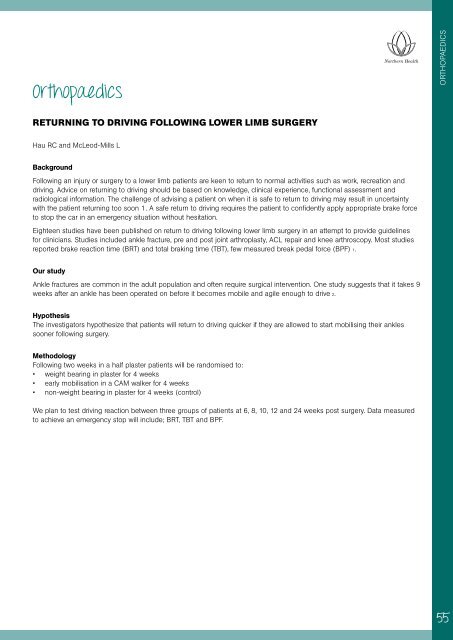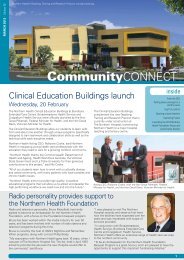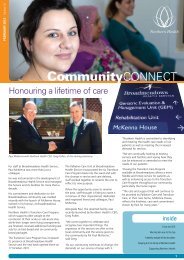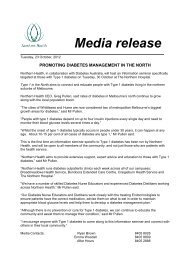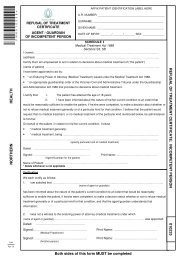Research Week Abstract Book - Northern Health
Research Week Abstract Book - Northern Health
Research Week Abstract Book - Northern Health
Create successful ePaper yourself
Turn your PDF publications into a flip-book with our unique Google optimized e-Paper software.
Orthopaedics<br />
ORTHOPAEDICS<br />
RETURNING TO DRIVING FOLLOWING LOWER LIMB SURGERY<br />
Hau RC and McLeod-Mills L<br />
Background<br />
Following an injury or surgery to a lower limb patients are keen to return to normal activities such as work, recreation and<br />
driving. Advice on returning to driving should be based on knowledge, clinical experience, functional assessment and<br />
radiological information. The challenge of advising a patient on when it is safe to return to driving may result in uncertainty<br />
with the patient returning too soon 1. A safe return to driving requires the patient to confidently apply appropriate brake force<br />
to stop the car in an emergency situation without hesitation.<br />
Eighteen studies have been published on return to driving following lower limb surgery in an attempt to provide guidelines<br />
for clinicians. Studies included ankle fracture, pre and post joint arthroplasty, ACL repair and knee arthroscopy. Most studies<br />
reported brake reaction time (BRT) and total braking time (TBT), few measured break pedal force (BPF) 1.<br />
Our study<br />
Ankle fractures are common in the adult population and often require surgical intervention. One study suggests that it takes 9<br />
weeks after an ankle has been operated on before it becomes mobile and agile enough to drive 2.<br />
Hypothesis<br />
The investigators hypothesize that patients will return to driving quicker if they are allowed to start mobilising their ankles<br />
sooner following surgery.<br />
Methodology<br />
Following two weeks in a half plaster patients will be randomised to:<br />
• weight bearing in plaster for 4 weeks<br />
• early mobilisation in a CAM walker for 4 weeks<br />
• non-weight bearing in plaster for 4 weeks (control)<br />
We plan to test driving reaction between three groups of patients at 6, 8, 10, 12 and 24 weeks post surgery. Data measured<br />
to achieve an emergency stop will include; BRT, TBT and BPF.<br />
55


